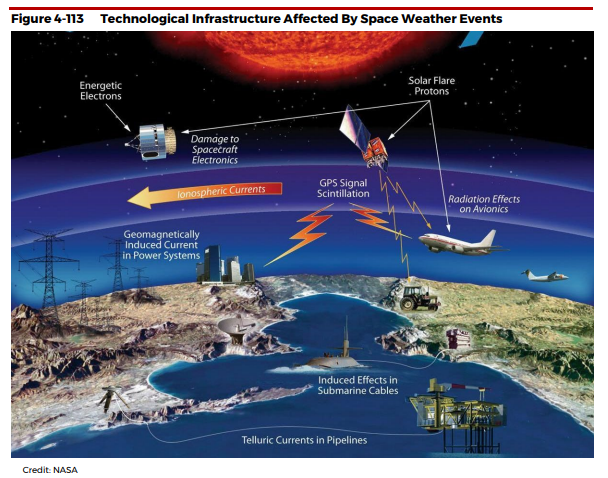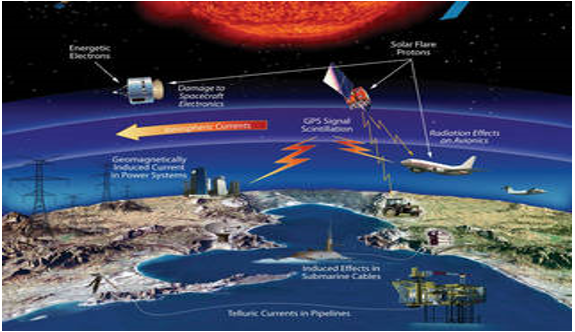SPACE WEATHER
NASA defines space weather as encompassing a range of phenomena occurring on the Sun, within the solar wind, and throughout the Earth's magnetosphere, ionosphere, and thermosphere. The adverse effects of space weather on technological systems have the potential to pose risks to human life and health. Examples of space weather phenomena include solar flares, solar wind, and coronal mass ejections, as well as any other extraterrestrial events that may impact Earth's technological infrastructure. The study of space weather is known as heliophysics.
The official source of space weather forecasts and warnings is NOAA's Space Weather
Prediction Center (SWPC), which is responsible for issuing alerts during solar events. The SWPC
leverages a range of solar-observing instruments on board satellites, such as NASA's Solar
Dynamics Explorer and the NASA/European Space Agency Solar and Heliospheric Observatory,
in addition to a wealth of other observations from ground-based magnetometers operated by
the US Geological Survey and other partners. With these resources, the SWPC runs sophisticated
models that enable the prediction of the arrival, duration, and severity of solar-generated storms.
While space weather forecasting is still an evolving field, the SWPC has demonstrated the ability
to provide accurate and timely warnings of space weather events, such as solar flares and
coronal mass ejections. These warnings can help protect infrastructure and personnel that could
be affected by space weather, such as power grids and astronauts on spacewalks. That being
said, space weather is a complex and unpredictable phenomenon, and there are limitations to
the accuracy of current forecasting capabilities.

Space weather events occur regularly, but their frequency and severity vary depending on the
activity of the Sun. The Sun goes through a roughly 11-year cycle of activity, with periods of high
activity (known as the solar maximum) and low activity (the solar minimum). During the solar
maximum, the Sun is more active and produces more space weather events. During the solar
minimum, the Sun is less active, and these events are less frequent. During periods of low activity,
space weather events can still occur and impact Earth. However, the likelihood and severity of
these events are generally lower than during the solar maximum.
According to the Solar Cycle 25 Prediction Panel, co-chaired by NOAA and NASA, the solar
minimum between Solar Cycle 24 and 25 happened in December 2019 when the 13-month
smoothed sunspot number fell to 1.8 (NOAA 2020). Thus, began Solar Cycle 25, with peak
sunspot activity expected in July 2025. Solar Cycle 24 was average in length at 11 years and had
the fourth-smallest intensity since regular record-keeping began with Solar Cycle 1 in 1755. It was also the weakest cycle in 100 years. Solar maximum occurred in April 2014 with sunspots peaking
at 114 for the solar cycle, well below average, which is 179. Solar Cycle 25 is forecast to be a fairly
weak cycle, the same strength as cycle 24, with a solar maximum peak of 115 sunspots.
The effect of climate change on the probability of space weather is discussed in Section 4.12.6
Climate Change Considerations. Discussion of the populations likely to be most severely
impacted is provided in Section 4.12.8 Vulnerability of Jurisdictions, specifically in the subsection
titled Population Impacts.
CASE STUDY

Technological infrastructure affected by space weather
In the mid-1800's disruptions of the telegraph system by solar flares were recorded including one event on September 2, 1859 when telegraph service was disrupted for several days by a severe solar storm.
When radio was invented in the early 1900's operators noticed that the sun interfered with radio transmissions.
A geomagnetic storm CME ejected from the sun on March 9, 1989 caused transformer failure and the collapse of the Hydro-Québec power network on March 13, 1989 leading to a nine hour blackout that affected over 6 million people.
In the 1960's space weather caused problems including outages and loss of data for weather satellites. The term space weather was coined to define this solar activity.
Magnetic storms also cause:
- Aurora borealis, the northern lights, and aurora australis, the southern lights
- Communication disruptions
- Radiation hazards to orbiting astronauts and spacecraft
- Current surges in power lines
- Orbital satellite degradation
- Corrosion of oil pipelines
As society's reliance on technological systems grows, so does our vulnerability to space weather. The ultimate goal in studying space weather is to develop the ability to foretell events and conditions on the Sun before they reach Earth to warn the public and affected infrastructure about space weather events that may produce potentially harmful effects on society and the economy. If we can create a warning system with sufficient advanced notice and reliable accuracy then preventive or mitigating actions can be taken.
